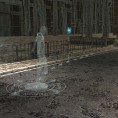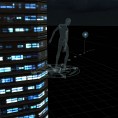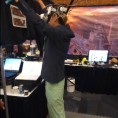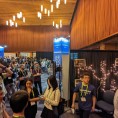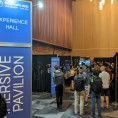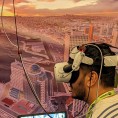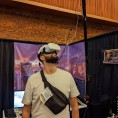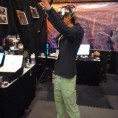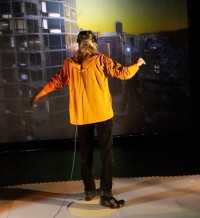
HyperJumping in Virtual Vancouver: Combating Motion Sickness by Merging Teleporting and Continuous VR Locomotion in an Embodied Hands-Free VR Flying Paradigm
Motion sickness, unintuitive navigation, and limited agency are critical issues in VR/XR impeding wide-spread adoption and enjoyable user experiences. To tackle these challenges, we present HyperJump, a novel VR interface merging advantages of continuous locomotion and teleportation/dashing into one seamless, hands-free, and easily learnable interface for flying and ground-based locomotion.
Users step onto a virtual hoverboard and simply lean (or move their head) in the direction they’d like to fly in a highly naturalistic Virtual Vancouver 3D model, freeing up hands for other interactions. When virtual speeds reach levels likely to induce motion sickness, HyperJump adds intermittent jumps (teleporting every second, synched to the music beat) instead of accelerating further. The further you lean the further you jump, without increasing continuous travel speed (optic flow) or motion sickness. This allows for easy-to-learn and hands-free precise locomotion across small– to large-scale environments (ground-based and flying), without having to switch interfaces or movement metaphor, or increasing risk of motion sickness.
HyperJump will be exhibited at the 2022 Siggraph conference in Vancouver, BC, Canada in case you’d like to try it out! [patent pending]. the 3D Virtual Vancouver model was provided by GeoSim Cities inc.
We are currently working on making HyperJump available — stay tuned.
For our earlier work on HyperJump for ground-based locomotion and how it affects spatial orientation/updating, see our project website on Integrating Continuous and Teleporting VR Locomotion into a Seamless “HyperJump” Paradigm.
Project video & images
1-minute teaser video
Full project video for Siggraph 2022
Publications & Exhibits on HyperJump Flying
https://dl.acm.org/doi/10.1145/3532834.3536211
Patent details
Media Coverage on HyperJump Flying
below are a few selected media coverages on this project and potential applications
Impressions from our HyperJump booth at the Siggraph 2022 Immersive Pavillion
Publications on HyperJump Ground-based Locomotion
Related work
Ground-based HyperJump locomotion
For our earlier work on HyperJump for ground-based locomotion and how it affects spatial orientation/updating, see our project website on Integrating Continuous and Teleporting VR Locomotion into a Seamless “HyperJump” Paradigm.
Discussion & Reframing on Continuous vs. Discontinuous (Teleport) Locomotion in VR
Short on time? here’s a 2-minute brief version of this talk


